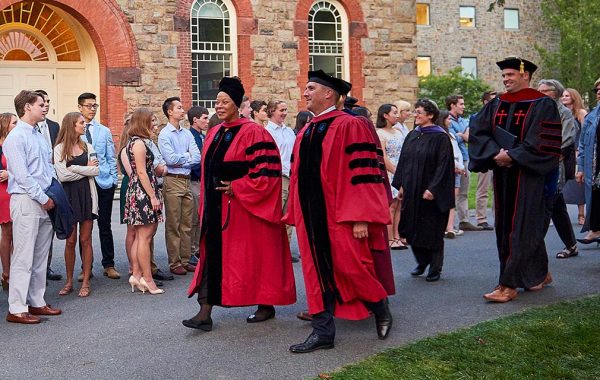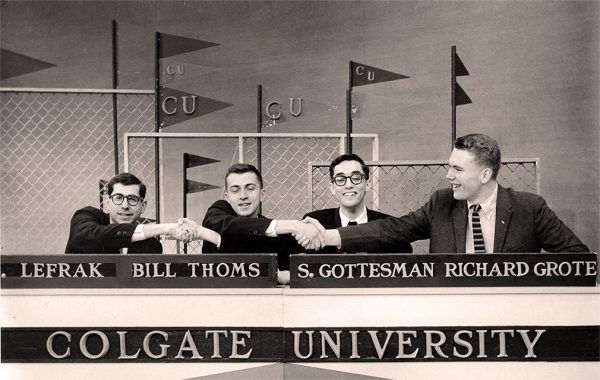Love from the Western Pacific

Hafa Adai from Guam — where America’s day begins!
Today was truly a special day. I had dinner with my 90-year-old mother (local land crabs cooked in coconut milk) and picked up my latest copy (autumn 2017) of the Colgate Scene. Spending time with my mother is always special. Getting the Colgate Scene is equally special, especially when I can remember how much my parents sacrificed to send me to New York to go to college. And I always count my blessings when I get the Scene.
The autumn 2017 edition left me filled with many emotions. I smiled when I saw the picture of the new dean of the faculty (pictured above), a woman, a member of the Class of ’87, and a person of color, walk alongside the president to start off the convocation. The struggles of the ’70s, the challenges of the ’80s and ’90s, and Colgate’s spotlight moments in the beginning of the 21st century all seemed to focus on Dean Tracey Hucks for me. I smiled thinking that the best and the brightest in academia are Colgate graduates. I was happy that a scholar/leader who is a fellow graduate will help lead Colgate and inspire new graduates to pursue academic careers.
I wiped away more than a few tears reading Vanessa Fernandez’s essay about her parents’ sacrifices and how much they mean to her in driving to succeed. My parents lived through World War II on Guam. My father graduated from high school, never went to college, and retired from administrative work for the government of Guam. My mother’s education was cut short because of the war. Her experiences and culinary reputation led to a career in teaching students with disabilities how to cook using local fruits and vegetables. With no tangible recipe for raising children who will succeed academically, my parents managed to send all five of us to college. Four of us have graduate degrees. Two of us have earned doctorates. We’ve all given back to our communities. My greatest Colgate regret is my parents did not see me walk across the stage as the first Chamoru student to graduate from Colgate. I hope Vanessa’s parents will be able to attend her graduation in four years.
The photographs in the Scene are just amazing. They bring back wonderful memories. Scenes from the Colgate campus continue to make me marvel at natural beauty more than the buildings that add man-made ornaments to a beautiful landscape. Sometimes the colors of our island sunsets remind me of the colors of the leaves in the fall in central New York. And the white sandy beaches remind me of the new snow on the ground in January.
I chuckled reading how Nancy Gorman and Jeffrey Kaufman met in New York City. Nancy is a good friend and someone who is responsible for many funny moments in Hamilton. Happiness and love begin at Colgate, are developed because of Colgate, and continue to be shared by Colgate.
The end of the issue brought on some sadness. I was sorry to read of Bruce Selleck’s passing. I never had Bruce in a class, but I had great conversations with him when I walked through Lathrop Hall or ran into him downtown. He treated me like a real colleague when I worked on the admissions staff. Thinking of Bruce makes me think of all the great Colgate students and graduates from small towns in upstate New York. I’m glad I have some good memories of Bruce.
I’ve been blessed with great friends, great experiences, and fulfilling opportunities. The Scene reminds me more and more of the great years as an undergraduate at Colgate and to put those years near the top of the list of blessings.
Juan Flores ’80
Tamuning, Guam
Continuing the hello tradition
Reading President Casey’s message in the autumn ’17 Scene reminded me of my own use of the hello tradition.
Until I retired last year, I spent most of my life working with children and youth at the opposite end of the spectrum from Colgate’s student population. As the leader of large residential treatment programs, it was my job to welcome to campus youth who had been abused, neglected, and abandoned, and had failed in numerous other, less-restrictive treatment settings. Having lost control of their lives, usually through no fault of their own, these young people arrived hurt, angry, and suspicious of adults.
Our relationship, at the core of our healing process, always began with a smile, a friendly handshake, and a warm hello. Whenever we met again on campus, there was always a repeat of the hello tradition. As I would often remind my younger staff members, working with challenging youth was a bit like having an ATM account with each of these youth. If you didn’t make a deposit, even as simple as a friendly hello, there would be nothing in your account to draw on when times were tough. And times in these residential treatment programs could be very tough.
So, the hello tradition works wonders in many diverse settings. Thank you to President Casey for reminding us all of its importance.
William M. Powers ’73
Allentown, Pa.
Quiz bowl: Colgate vs. Mount Holyoke

The article in the summer 2017 Scene on the quiz bowl was very interesting but missed an important detail that was reported in the Colgate Maroon Nov. 16, 1955.
In the Scene, Jim Watchel’s recollections of the spring 1955 team activities and the vigorous rivalry between colleges on the quiz bowl circuit at that time was interesting but only half of the 1955 story.
The 1955 fall quiz bowl team of Marty Heyert ’56, Peter Gould ’56, Tito Macias ’57, and Andy Tangalos ’56 defeated Mount Holyoke in November ’55 by the score of 150 to 140 in a match that was marred by denying Mount Holyoke points for a correct answer, which would have resulted in a tie. The Colgate team faced a rematch — won by Mount Holyoke.
For those of us who enjoyed the heady days of quiz bowl notoriety, we appreciate the work done by the Scene to share the excitement of those days.
Jack Goodreds ’56
Delray Beach, Fla.
From the editor
For the spring 2017 issue of the Scene, Trey Spadone ’20 wrote a piece about his experience attending the Women’s March in Washington, D.C., last year. In response to his write-up, Spadone recently received a disparaging, anonymous letter.
It is against our policy to publish anonymous letters, so you will not find it in this issue or in the future. Furthermore, the letter’s derogatory comments are not something we would give voice to in this magazine.
Although the Scene welcomes all opinions, in these heated political times, it is imperative that we are respectful of each other — even if we disagree.
Aleta Mayne, managing editor
We asked, you answered
Last fall, we sent out a survey to alumni and parents to ask your opinions of the Colgate Scene. The questionnaire went to 43,378 readers, and we heard back from 2,663 respondents. Thank you to everyone who took the time to respond. Here’s what we’ve learned:
Who responded:
81% alumni
– 14% parents of a current student
– 11% parents of a graduate
How often you read the Scene:
65% of alumni report reading every issue of the Scene
– 79% of alumni from the Class of 1979 and earlier read every issue
– 62% of alumni from the 1980s and 1990s read every issue
– 41% of alumni from 2000+ read every issue
How much you read:
56% of alumni read most or all of each issue
– 65% of parents of alumni read most or all of each issue
– 51% of parents of students read most or all of each issue
Preference for print:
85% of alumni read the magazine exclusively in print
– 91% of parents of alumni read the magazine exclusively in print
– 65% of parents of students read the magazine exclusively in print
– Fewer than 7% of readers consume the Scene mostly online
Top content of interest:
Class notes (84%)
– Campus controversies (77%)
– Campus facilities and growth (74%)
– Colgate history and traditions (73%)
– Obituaries (68%)
– Alumni profiles (65%)
Other takeaways:
– Across audiences, the vast majority of Scene readers feel informed about Colgate today.
– Generations are split: Older alumni tend to rely on the Scene print publication for information, while younger alumni are more likely to also engage in Colgate’s electronic media for information.
– Overall, alumni want the tone of the Scene to stay the same, although approximately 30% would prefer it to be more cutting edge, more nostalgic, or more scholarly.
– Readers appreciate the Scene’s photography, ease of reading, and design.
The Scene welcomes letters. We reserve the right to decide whether a letter is acceptable for publication and to edit for accuracy, clarity, and length. Letters deemed potentially libelous or that malign a person or group will not be published. Letters should not exceed 250 words. You can reach us by mail, or e-mail sceneletters@colgate.edu. Please include your full name, class year if applicable, address, phone number, and/or e-mail address. If we receive many letters on a given topic, we will run a representative sample of the opinions expressed.






